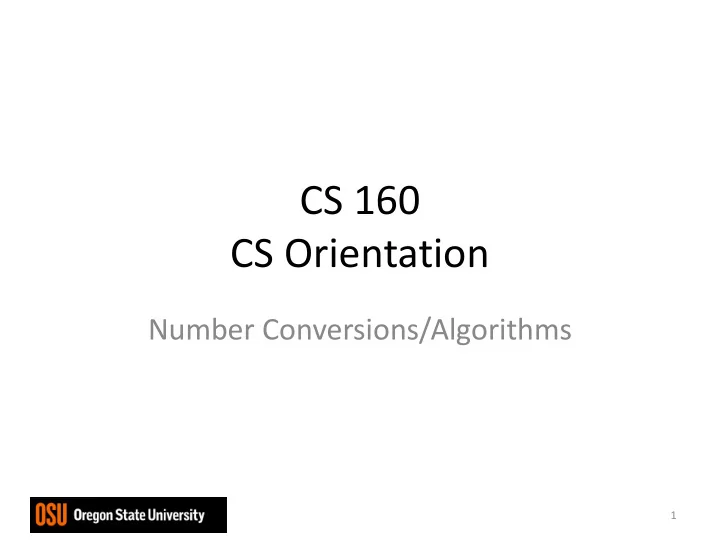

CS 160 CS Orientation Number Conversions/Algorithms 1
Odds and Ends… • Get Assignment #1 demoed this week!!! • TA offices in LINC 435 and KEC 1087! • Keep working on Assignment #2! 2
Digital Realm • Based on discrete #s – Specifically: Circuits • Binary, i.e. base 2 – 0 or 1 • What base do most people use? – What is the range for each digit? • What is Hexadecimal?, i.e. base 16 – What is the range for each digit? 3
Decimal, Binary, & Hex • Decimal – Powers of 10 • Binary – Powers of 2 • Base X to Base 10 conversion – 32 (base 10): 3*10 1 + 2*10 0 = 32 (base 10) – 100000 (base 2): 1*2 5 + 0*2 4 + 0*2 3 + 0*2 2 + 0*2 1 + 0*2 0 = 32 (base 10) – How do we express 35 (base 10) in base 2 vs. base 16? 4
Get into groups 4-5 • Convert 11110010 (base 2) to base 10. • Convert 130 (base 10) to base 2. 5
More Binary • What is each digit called? • What is a Byte? • How many numbers can be expressed in a Byte? – Signed/Unsigned • What is the smallest number? • What is the largest number? • Help: http://classes.engr.oregonstate.edu/eecs/fall2016/cs160-001/Exam1Review1.txt 6
Get into groups 4-5 • What is the smallest/largest unsigned number in 16 bits? • What is the smallest/largest signed number in 16 bits? • How does this change for x bits? 7
Problem Solving in Everyday Life 1. Identify the problem. 2. Understand the problem. 3. Identify alternative ways to solve problem. 4. Select best alternative. 5. List solution steps for alternative chosen. 6. Evaluate solution. 0-8
Difficulties with Problem Solving • Lack of problem solving experience • Inadequate solution steps • Incorrect problem definition • Alternatives chosen incorrectly • Invalid logic • Incorrect solution evaluation 0-9
Let’s write the directions to start a car 10
Recommend
More recommend